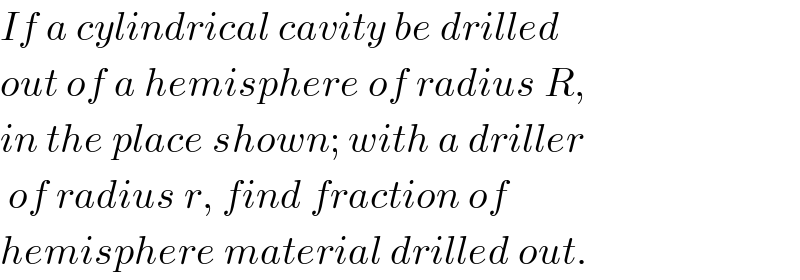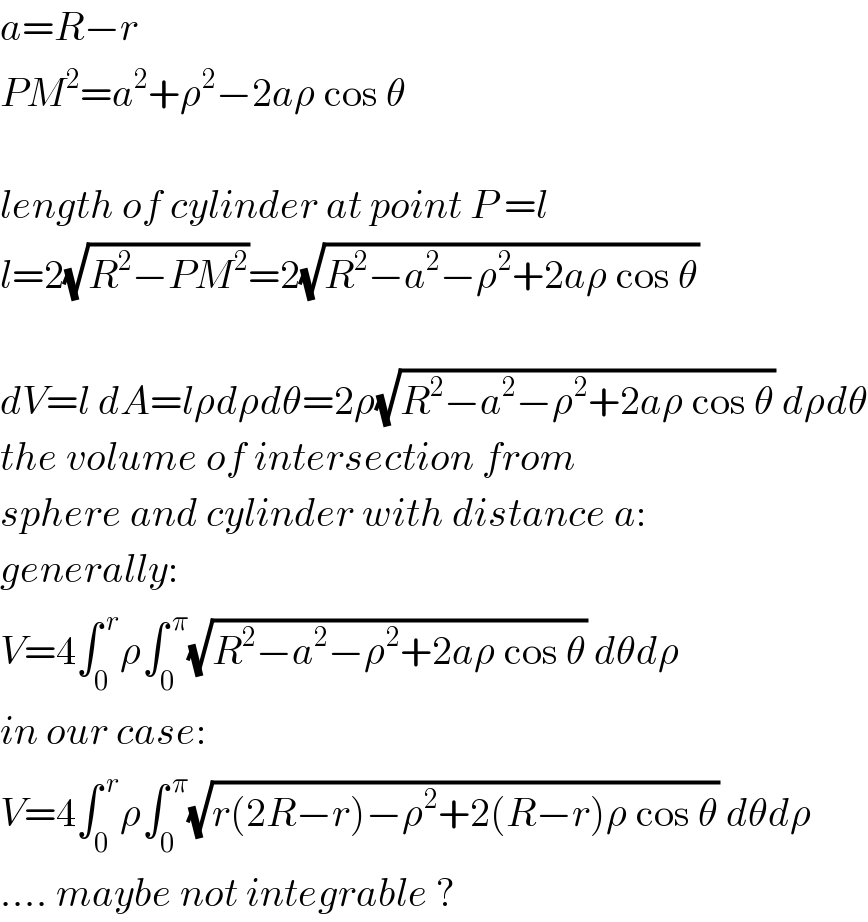
Question Number 85074 by ajfour last updated on 18/Mar/20

Commented by ajfour last updated on 19/Mar/20

$${If}\:{a}\:{cylindrical}\:{cavity}\:{be}\:{drilled} \\ $$$${out}\:{of}\:{a}\:{hemisphere}\:{of}\:{radius}\:{R}, \\ $$$${in}\:{the}\:{place}\:{shown};\:{with}\:{a}\:{driller} \\ $$$$\:{of}\:{radius}\:{r},\:{find}\:{fraction}\:{of} \\ $$$${hemisphere}\:{material}\:{drilled}\:{out}. \\ $$
Answered by mr W last updated on 19/Mar/20

Commented by mr W last updated on 19/Mar/20

$${a}={R}−{r} \\ $$$${PM}^{\mathrm{2}} ={a}^{\mathrm{2}} +\rho^{\mathrm{2}} −\mathrm{2}{a}\rho\:\mathrm{cos}\:\theta \\ $$$$ \\ $$$${length}\:{of}\:{cylinder}\:{at}\:{point}\:{P}\:={l} \\ $$$${l}=\mathrm{2}\sqrt{{R}^{\mathrm{2}} −{PM}^{\mathrm{2}} }=\mathrm{2}\sqrt{{R}^{\mathrm{2}} −{a}^{\mathrm{2}} −\rho^{\mathrm{2}} +\mathrm{2}{a}\rho\:\mathrm{cos}\:\theta} \\ $$$$ \\ $$$${dV}={l}\:{dA}={l}\rho{d}\rho{d}\theta=\mathrm{2}\rho\sqrt{{R}^{\mathrm{2}} −{a}^{\mathrm{2}} −\rho^{\mathrm{2}} +\mathrm{2}{a}\rho\:\mathrm{cos}\:\theta}\:{d}\rho{d}\theta \\ $$$${the}\:{volume}\:{of}\:{intersection}\:{from} \\ $$$${sphere}\:{and}\:{cylinder}\:{with}\:{distance}\:{a}: \\ $$$${generally}: \\ $$$${V}=\mathrm{4}\int_{\mathrm{0}} ^{\:{r}} \rho\int_{\mathrm{0}} ^{\:\pi} \sqrt{{R}^{\mathrm{2}} −{a}^{\mathrm{2}} −\rho^{\mathrm{2}} +\mathrm{2}{a}\rho\:\mathrm{cos}\:\theta}\:{d}\theta{d}\rho \\ $$$${in}\:{our}\:{case}: \\ $$$${V}=\mathrm{4}\int_{\mathrm{0}} ^{\:{r}} \rho\int_{\mathrm{0}} ^{\:\pi} \sqrt{{r}\left(\mathrm{2}{R}−{r}\right)−\rho^{\mathrm{2}} +\mathrm{2}\left({R}−{r}\right)\rho\:\mathrm{cos}\:\theta}\:{d}\theta{d}\rho \\ $$$$....\:{maybe}\:{not}\:{integrable}\:? \\ $$
Commented by ajfour last updated on 19/Mar/20

$${Thanks}\:{Sir},\:{it}\:{was}\:{great}\:{following} \\ $$$${your}\:{solution}! \\ $$
Commented by mr W last updated on 19/Mar/20

$${thanks}\:{to}\:{you}\:{too}\:{sir}! \\ $$$${i}\:{have}\:{problem}\:{to}\:{solve}\:{the}\:{final} \\ $$$${integral}.\:{do}\:{you}\:{have}\:{an}\:{idea}? \\ $$
Commented by mr W last updated on 22/Mar/20
![an other attempt: V=4∫_(−r) ^( r) ∫_0 ^(√(r^2 −x^2 )) ∫_0 ^(√(R^2 −(a−x)^2 −y^2 )) dzdydx =4∫_(−r) ^( r) ∫_0 ^(√(r^2 −x^2 )) (√(R^2 −(a−x)^2 −y^2 ))dydx =2∫_(−r) ^( r) {[R^2 −(a−x)^2 ]sin^(−1) ((√(r^2 −x^2 ))/(√(R^2 −(a−x)^2 )))+(√((r^2 −x^2 )[R^2 −r^2 −(a−x)^2 +x^2 ]))}dx =2∫_(−r) ^( r) [(R^2 −a^2 +2ax−x^2 )sin^(−1) ((√(r^2 −x^2 ))/(√(R^2 −a^2 +2ax−x^2 )))+(√((r^2 −x^2 )(R^2 −r^2 −a^2 +2ax)))]dx](Q85465.png)
$${an}\:{other}\:{attempt}: \\ $$$${V}=\mathrm{4}\int_{−{r}} ^{\:{r}} \int_{\mathrm{0}} ^{\sqrt{{r}^{\mathrm{2}} −{x}^{\mathrm{2}} }} \int_{\mathrm{0}} ^{\sqrt{{R}^{\mathrm{2}} −\left({a}−{x}\right)^{\mathrm{2}} −{y}^{\mathrm{2}} }} {dzdydx} \\ $$$$=\mathrm{4}\int_{−{r}} ^{\:{r}} \int_{\mathrm{0}} ^{\sqrt{{r}^{\mathrm{2}} −{x}^{\mathrm{2}} }} \sqrt{{R}^{\mathrm{2}} −\left({a}−{x}\right)^{\mathrm{2}} −{y}^{\mathrm{2}} }{dydx} \\ $$$$=\mathrm{2}\int_{−{r}} ^{\:{r}} \left\{\left[{R}^{\mathrm{2}} −\left({a}−{x}\right)^{\mathrm{2}} \right]\mathrm{sin}^{−\mathrm{1}} \frac{\sqrt{{r}^{\mathrm{2}} −{x}^{\mathrm{2}} }}{\sqrt{{R}^{\mathrm{2}} −\left({a}−{x}\right)^{\mathrm{2}} }}+\sqrt{\left({r}^{\mathrm{2}} −{x}^{\mathrm{2}} \right)\left[{R}^{\mathrm{2}} −{r}^{\mathrm{2}} −\left({a}−{x}\right)^{\mathrm{2}} +{x}^{\mathrm{2}} \right]}\right\}{dx} \\ $$$$=\mathrm{2}\int_{−{r}} ^{\:{r}} \left[\left({R}^{\mathrm{2}} −{a}^{\mathrm{2}} +\mathrm{2}{ax}−{x}^{\mathrm{2}} \right)\mathrm{sin}^{−\mathrm{1}} \frac{\sqrt{{r}^{\mathrm{2}} −{x}^{\mathrm{2}} }}{\sqrt{{R}^{\mathrm{2}} −{a}^{\mathrm{2}} +\mathrm{2}{ax}−{x}^{\mathrm{2}} }}+\sqrt{\left({r}^{\mathrm{2}} −{x}^{\mathrm{2}} \right)\left({R}^{\mathrm{2}} −{r}^{\mathrm{2}} −{a}^{\mathrm{2}} +\mathrm{2}{ax}\right)}\right]{dx} \\ $$
